Recent Activity

First, we are talking about two distinct types of hellebores. Without getting too technical, we can just say that they grow differently, flower differently and to a lesser degree, are cared for differently.
The first two pictured - Pink Frost and Ivory Prince - are complex hybrids in the group of caulescent or stemmed hellebores. These tend to be fully evergreen so foliage is left intact until after flowering (flowers from top of leafed stem) as that stem will not flower again, although the foliage can remain attractive indefinitely. Caulescent hellebores also tend to grow taller than the stemless forms, don't live as long, resent division, have heavy, often patterned foliage that remains quite durable, have a limited color range and in the case of the hybrids, are almost always sterile.
The rest of your photos are examples of Helleborus x hybridus or the so called "oriental hybrids". These are stemless or acaulescent forms with leaves and flowers emerging separately from the root crown. These are the types of hellebores that typically have their foliage removed in late winter before flowering as it looks pretty tatty by that time as well as making it easier for the flowers to present without the distraction of old, tired foliage obscuring them. Once the flowers emerge, new foliage growth follows rapidly thereafter to replace whatever might have been removed previously.
Acaulescent hellebores tend to be squatter, longer lived, more readily divisible and generally self-seed freely. And of course the xhybridus have the widest range of color and forms available.

Some plants are easy to talk about and describe.......others are not. Hellebores fit into that second group :-) So none of your questions are ignorant, Marie. I have just not explained myself well.
Let's move away from botanical terms and just talk about stemmed hellebores and stemless ones. And I am going to omit referring to any species plants for this purpose as species hellebores tend to be unknown to most US gardeners as they are often less hardy and rarely as showy as the hybrids and are typically found in the gardens of only mild climate hellebore collectors.
Stemmed hellebores are often complex interspecies and intersectional hybrids. They produce a leafy stem that will bear flowers at the terminal end of the stem. So leaves and flowers appear on the same stalk (stem). They also tend to have quite durable and often heavily patterned or marbled foliage that will remain looking good indefinitely so they do not get pruned back before the flower season and most gardeners will not remove these leafed stems until the foliage starts to get rather ugly looking (as all evergreen foliage eventually does). I have had some last a good 2-3 years before it needed to be removed. As stemmed hellebores will not rebloom a second time from the same stem, some gardeners don't wait and remove those flowered stems whenever the flowers fade. FWIW, a stemmed hellebore will push out new grow each season so there should be no lack of flowers even if the old stems are left in place. And these complex hybrids are also very often sterile and frequently patented so no self seeding and no division - clumps either need to gradually expand on their own or you purchase additional plants :-)
Until recently, stemless hellebores were the ones grown most often by most gardeners and are almost exclusively reserved for the xhybridus varieties or the so-called oriental hybrids. So-called because H. orientalis is the primary parent and for donkeys' years these were simply called oriental hybrids. Orientalis as a species is virtually unknown in this day and almost all xhybridus forms have ventured many generations beyond that simple parentage. That's where the complexity of colors and markings come from - a little dash of this species and a dash of another :-))
These are considered stemless because the leaves and flowers appear from the root crown on separate stalks - flowers first in late winter or early spring, followed shortly thereafter by a stalk that will develop into new leaves. These are the hellebores that most cut back the old foliage on in winter, as the foliage typically looks pretty done in by that time of year and removing all the old foliage lets the usually downward facing flowers show their stuff without being covered with leafy greenness. Few if any stemless hellebore/xhybridus are patented and all are very fertile so self seeding of an established happy clump is a given. They can also be easily divided to increase your stock and relocate to other spaces.
As I mentioned, almost all hellebores sold are hybrids with the exception of H. niger or the Christmas rose. You will find a few collectors growing argutifolius or foetidus but with only pale green flowers, they are not favorites, with most folks sticking to the hybrids.
Debra, your Ivory Prince is an example of a stemmed hellebore, a sterile complex hybrid. Royal Heritage is a seed strain of xhybridus, so a stemless and self seeding hybrid.
I hope this makes things a little clearer but feel free to come back with any questions and I will do my best to answer them :-)

Though I don't think GG said this in frank words, the newer complex hybrid caulescent plants, tend to be a bit more on the finicky side (for me at least) than the common garden hybrids in their care needs. But at least I can grow them, where h niger (one of the parents, aka the Christmas Rose) remains intolerant of my climate.
Also a note, that just almost no plant (and certainly not hellebores) enjoy mostly shade. They will tolerate it, but blooming is far far better in a situation with morning and maybe even late evening sun and overhead (noon) shade. Remember, sunlight drives photosynthesis.

Similar. Aureola with Sea Patriot and Chinese Sunrise.
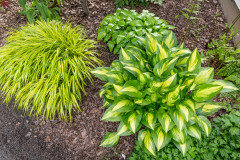

I'd go with Aureola as well. All Gold is too much of a solid color and lacks the detail and delicacy of Aureola. I have a pot of Aureola with my potted hostas as well.

This forum is pretty dead. Try posting in Perennials.
Rozanne is totally hardy in the ground, so winter care is more a function of the pot (material, size) and the temperature than the plant. You might have trouble if the soil in the container freezes. I can't help further since in my climate the temperature rarely goes low enough for overwintering potted plants to be to be of concern.

Since your winter temperatures have the potential to drop down to -10F (and possibly lower), I would not leave the pot out unprotected. Plant roots tend to be the most cold vulnerable portion of a plant and in a container, they are relatively unprotected to ambient air temperatures, which tend to to be far colder than what the roots in the ground would be exposed to, insulated by all that soil mass.
I would either dig a hole in the garden somewhere to heel the planted pot in or store in the garage. As long as it is not exposed to subfreezing temps there.

Looks like the bloom is color changing as it ages. very nice. in which website did you first see it at?

It is impossible to say for sure. The flower color of most Hydrangea macrophyllas is typically extremely variable due to soil chemistry. And this can vary widely, even within the same property. You will very likely get a similar late season coloration from any mac that leans towards a pink inseason flower color

Nice website for that conservation project north of Portland, Dorian. Good photography as well. The only to get a duplicate hydrangea is to obtain cuttings from the shrub in the picture and identically replicate the soil nutrients and environment. If they can only figure out how to let me smell those lilacs via the Internet, they will be rich!

Candytuft - Iberis sempervirens - is a low growing, spreading evergreen subshrub. In my area, it blooms from early February through into late spring or early summer. Once the bloom has faded, it is cut back and remains a tidy evergreen mound for the rest of the season.
Sempervirens means evergreen. 😊

the farmers usual lament.. it will be better next year..
Not a lament but a farmer's (and gardener's) optimism and hope.

Lilacs in the PNW bloom before the weather warms up very much. I have found that that affects the scent of a lot of supposedly fragrant plants - the later the bloom period, the warmer the weather and the better the fragrance can be appreciated.

Walking through a lilac collection today (65 degrees) I’d say mild is a good way to put the fragrance of this one

Here are a few suggestions:


Instead of the low planters, I'd invest in a few tall, bold, heavy pots to place in strategic spots on the patio -- maybe by the main doorway, by a transition point, and/or where you want to draw the eye to a distant view. You can have dwarf conifers or colorful annual flowers in the pots -- whatever suits your style. Such a gorgeous patio and home!

This is Cumbria, one of the wettest places in England. Shade is rarely going to be a requirement and anything painted white will be covered in lichen in a short time. A stone or matural timber pergola would be more in keeping.

Beautiful!

Thank you gang for the nice comments. As far as feeding goes, I try to keep things simple. I use Espoma Plant/Flower/Rose Tone. Whichever is on sail when I need it. Middle March one cup per bush. Starting April 1/2 cup on the 1st and the same on the 15th. Also on the 1st I've started using about an 1/8 cup (a nice handful) of GOOD 10-10-10 plant food on each bush. I water everything in good with each feeding. I continue this routine until the 1st of September. No special feedings that cost $$$. I also exhibit my roses in the spring and fall. My roses do very well against folks that spend big time $$$ to get their perfect rose.
The big rose in the middle (Hot Princess) is the HT Queen at the Deep south District show last fall
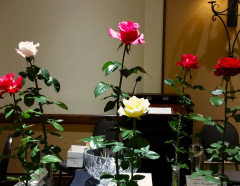
Also won the Miniflora Queen at that show
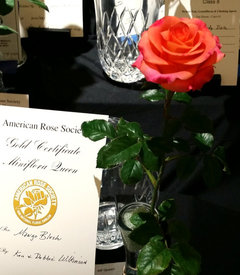
I usually do one show in the spring and 2 shows in the fall. Other than that, my doctors and my neighbors (my home also) get my roses.

Pink rose---My spray routine is very simple. Every two weeks (give a day or two either side because of weather) I use BioAdvance Disease Control mixed according to directions. I use a few drops of dish soap (Dawn) as a spreader sticker.
Artist---I don't do any rose shows on Mothers Day weekend. That weekend belongs to my wife. I will be at the South Metro Rose Show the following weekend.

Without seeing the situation I would plant a second, or even third, Fragrant Star. I like some cohesion in colour, form and layout which repetition brings. Then I'd pack the bed with May flowering tulips, again in a limited palette.

Dorian, with our extremely variable spring weather in the PNW, it is very hard to predict precisely when something will be in bloom here. Depending on temps, there is a window of as much as a month one way or the other.
I like floral's idea of bulking up on the Fragrant Stars. And then I would pick something else to compliment them now for your spouse's birthday.......perhaps a Flame Creeper azalea? Or anything else in bloom or just starting to bloom you may find at your garden center. Tulips might be okay for next season but most are typically over and done with by now.

They visit the feeder my sister has on her third story balcony. And she used to have a window feeder as well. But the hummingbirds are year round residents here so if you put out feeders, they will come! 😁






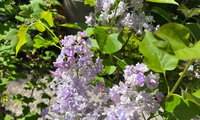

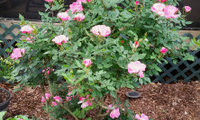
Nevermore44,
I'm in Zone 8A. I don't know that it gets full sun, but I think it gets decent sun. My purple coneflowers about 20 yards away get about the same amount of sun, and they bloom just fine. Yes, it does have a decent set of leaves at least.
I have a device that measures sunlight hours, and I'll make a note to measure that. If it doesn't get full sun, should I dig it up and plant it at a new location?